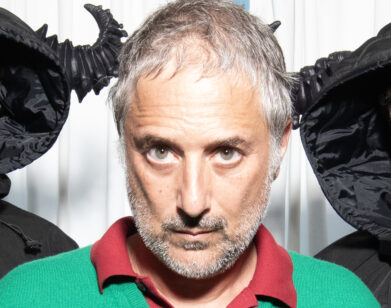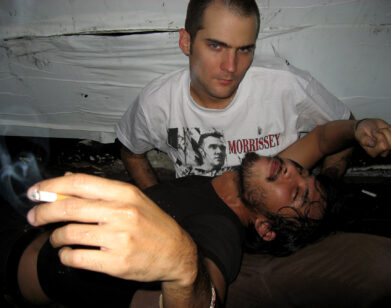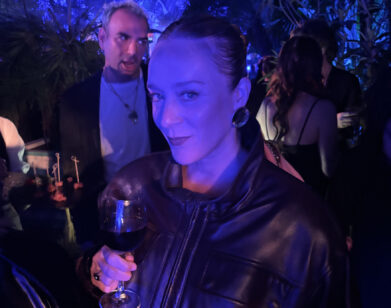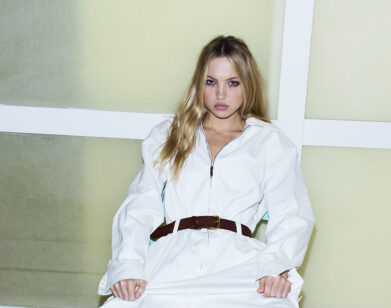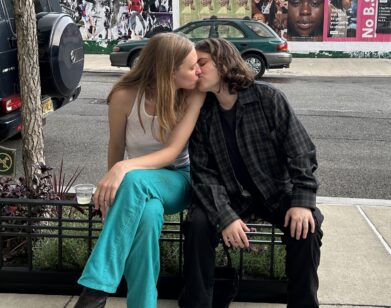Ed Templeton and William Strobeck On Skateboarding and Sweaters
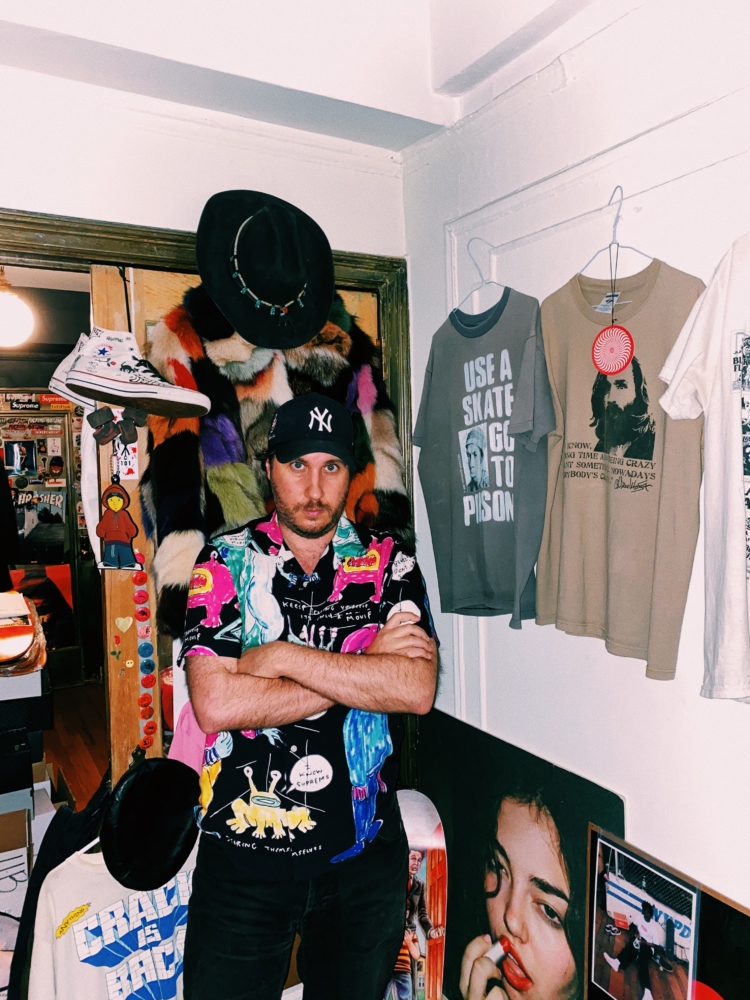
William Strobeck photographed by Vanna Youngstein.
The snap cardigan, whose silhouette was originally imagined by the French designer agnès b, connotes class and sophistication, as simplicity does—not skate culture. Fortunately, agnès b does not rely on shop glass to display her silhouette’s possibilities; fashion is meant to be worn after all, and maybe not even just worn. On Chrystie Street in February, a host of artists—including the three horsemen of the unpredictable, David Lynch, Gaspar Noé, and Jim Jarmusch—were invited to display photographs capturing their own interpretation of the garment. Their only restriction: a democratic dimension of 40 × 60 centimeters for all. Here, two artists and godfathers of skateboarding, Ed Templeton and William Strobeck, discuss their participation in the collection, photographing people on the fly, and backside flips. —BESSIE RUBINSTEIN
———
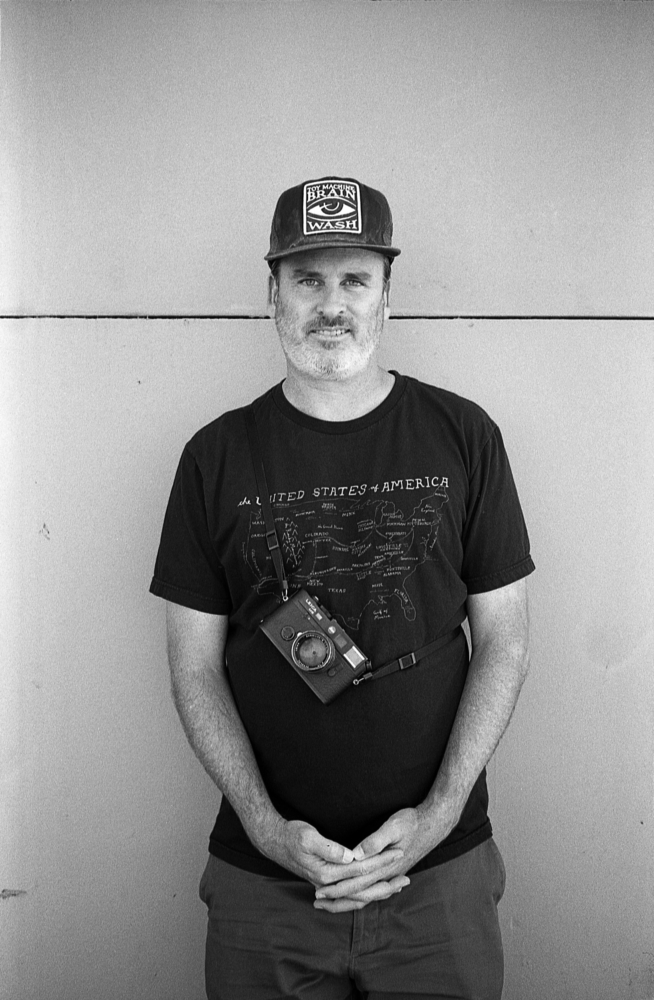
Ed Templeton photographed by Deanna Templeton.
WILLIAM STROBECK: I made it to New York for the opening, but I didn’t see you there. Where were you?
EDWARD TEMPLETON: I wasn’t in New York. I haven’t even seen the show actually. I just got a PDF showing all the works. I just saw your photo and everyone else’s. It’s really cool!
STROBECK: It was a cool show. It would have been nice to see you there. Obviously it’s a big move for you to come over to New York for that show. There were a lot of artists, and a lot of works in it. Yours was cool! Did you take it down by a ditch or a river?
TEMPLETON: Yeah, it’s the Santa Ana river bed. We call it Skip’s ditch. Because back in the days, in the mid ’80s, my friend Skip Pronier was the first person to find it. He started skating there. But I don’t know if other people call it Skip’s ditch. I think it’s just a local thing. All the old Huntington Beach skaters—if you say Skip’s ditch they know what you’re talking about. It’s been in a lot of videos. Geoff Rowley and Arto Saari and tons of people have skated that thing.
STROBECK: Is it the one where they put the wedge ramps on each side of the ditch and then Arto backside-flipped it?
TEMPLETON: Yeah!
STROBECK: It was amazing to see that footage! To see that in person would have been really amazing, but I remember just being like, it’s kind of crazy they built the wooden things for it. It was so big looking, and the trick looked so grand that it was kind of undeniable…
TEMPLETON: Yeah, it was amazing. I went down there to see that when they were doing it. A total Geoff Rowley production kind of thing, along with Daniel Harold Sturt. It was scary to drop in. I don’t know if I was prepared to do any tricks over that thing.
STROBECK: Yeah, the gap looks big.
TEMPLETON: It was more just the speed. When you drop in on that huge bank, you just go flying. But it gave me a new appreciation because that’s not even half of what dropping in on the mega ramp would be like.
STROBECK: I know, the mega ramp thing is really crazy. I don’t think you’ll ever know what it feels like unless you’re standing at the top of that thing, which I never have.
TEMPLETON: I have! I went up there and looked at it, and I was just like, no way am I dropping in. Honestly, it’s above my skill level.
STROBECK: That’s how I thought about Vert skating when I was younger and saw it on video. I could appreciate Danny Way and Colin [McKay] and all of them, though after a certain point it just felt like the same thing all the time. But when I went to a contest and saw it in person, it was pretty amazing!
How did you get involved with the show? I’m sure you know agnès b. I’ve never met her, but I know a lot of the artists who have done stuff in her shows like Harmony Korine, Ryan McGinley, and those guys. I actually have a piece by Harmony at my house. It was a screen print about E.T. and Bin Laden. There’s probably 30 of them, but I have one and I really love it. I remember reading that it was for one of agnès’s shows. She’s always backed creative stuff. Have you ever done anything with her?
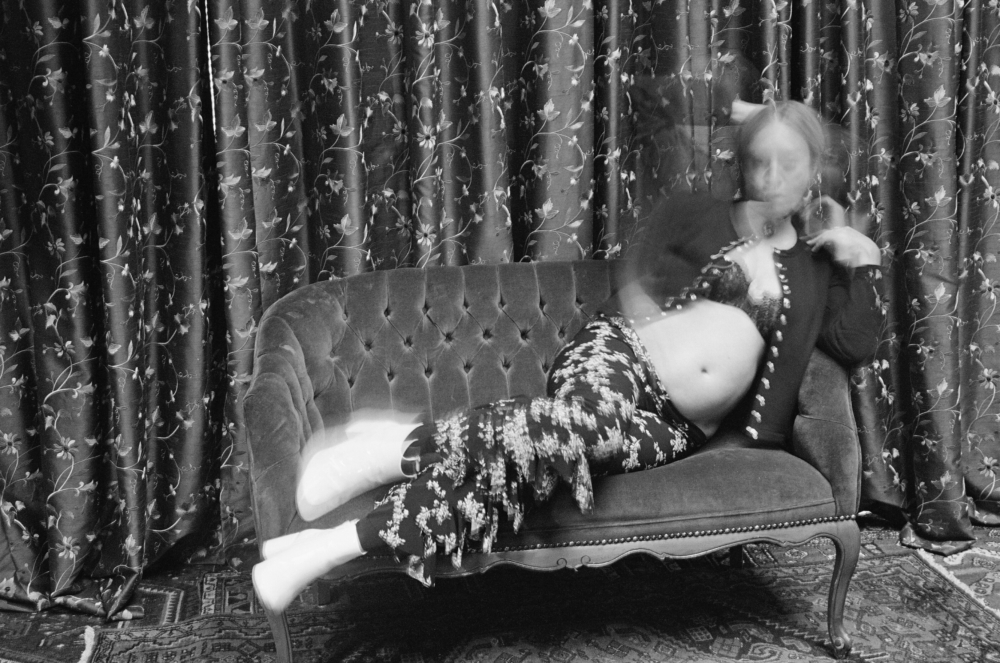
Chloe Sevigny captured by Jim Jarmusch for the collection. © Jim Jarmusch
TEMPLETON: There’s been talk of me doing something with the gallery in Paris at some point, but nothing has come to fruition. I’ve been included in a couple of group shows over the years that she’s done with the Galerie du Jour. I think they’re moving to a bigger space now in Paris. She’s been running a legit gallery for a long time. She represents Tim Barber, I think, and Harmony, who ended up having a retrospective at the Pompidou Center. Probably in no small part due to agnès.
STROBECK: I know! It feels like she can really help artists get to the next level. Funny story … I remember me and [skater] Anthony Pappalardo took a train cross country from New York to San Francisco. It was around 2003. When we got out there, he got called to go to Scott Johnston‘s wedding, and he needed a suit. We were skating around downtown and we saw the agnès b. store that was there. I was like, you should just go in there and get a nice suit, so you have it after the wedding. We were staying at this skate house, and he brought the suit back and was wearing it in the house. He was excited to have a suit. It’s really funny to think about that now, whenever I hear agnès b. I think of that story and my friend, this Italian kid, and how he felt like an adult wearing that suit.
TEMPLETON: I’m trying to picture Pappalardo wearing a nice suit right now!
STROBECK: It was right around when the Mosaic video came out, we went out there to film for that video. He’s got that Italian demeanor, you know? I’ve met his family, his mom works at the chocolate shop, his dad owns a pizza place. And then it’s just him in that suit with the feel of being an Italian dude, like, yeah, I look cool. It’s just funny. But I went over and saw all the work at the show and it looked really good. I have to go back and check it again before it ends on March 1. I haven’t had the chance to look at each photo.
TEMPLETON: I know this show is going to go to Tokyo. I plan on being in Tokyo this year at some point, so hopefully those two line up and I can go see it there.
STROBECK: That’d be great! When they asked me to do it, I didn’t really know much about the garment to be honest, but I went down to the store and grabbed a men’s one and a women’s one. I originally was going to have James Dean in front of the wall, but I couldn’t find the cardboard cutout of him that I wanted. I wanted an old school one and it was just all these new, colorful ones where he’s got bright red pants. I wanted one of the real old denim jean ones where he’s, like, pointing a finger to the left—I was gonna maybe hang the cardigan on his finger. But it just didn’t work out. Then I saw the Marilyn Monroe cutout, and that one looked right to me.
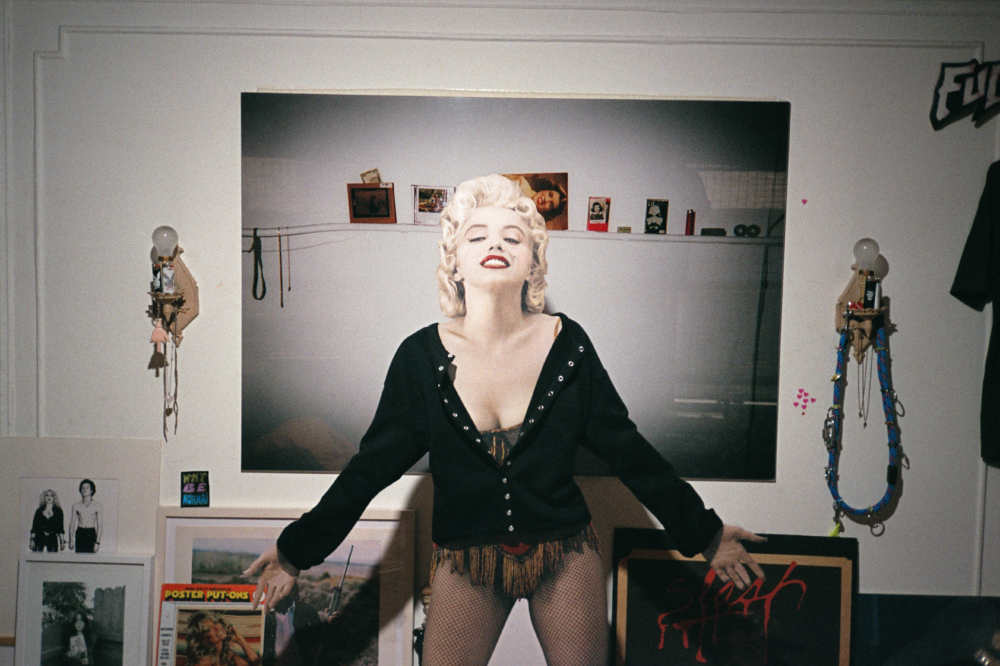
“Happy Birthday Mr. President,” 2020. © William Strobeck
TEMPLETON: So this was a concept beforehand? When I saw the photo, I thought maybe you had a Marilyn Monroe cutout in your house and you just put the cardigan on there. But I see you thought ahead of time and went out to get a cool cutout and do that. I know you shoot portraits of people in front of that wall in your house. That’s a fun Instagram series. As an outsider, I’ve seen a lot of people coming to your place.
STROBECK: It’s been pretty fun. But I wanted to do something where I didn’t need to rely on somebody else. So I just thought of that idea. I was looking for cardboard cutouts that would make sense and there were some really funny ones. But I wanted it to be classic and James Dean was kind of the first one. I was going to put a woman’s cardigan on James Dean because I thought it would be different and that he, as an icon, could pull off the look.
TEMPLETON: Were you looking for these just on the internet?
STROBECK: I was out of town so I ended up ordering one online. Then it showed up and I unwrapped it and put it together. You have to fold in certain ways to get it together. There was cardboard in the armpits and in between the fingers, so I had to cut it all out by hand to be sure it would look real. There’s cardboard between her legs, too, because I couldn’t cut that out. But it matches the color of my wall in the background. So it kind of works out.
TEMPLETON: It looks incredible. I heard that some reviewer thought it was photoshopped.
STROBECK: Yeah, I had to explain that it was real, actually. I had to pin the arms of the sweater behind because they were baggy for the cutout. I put books behind her so the fold flap at the back would rest on these books and it would look like she was leaning forward more. I took a couple rolls of photos of it. And then I found one that was the best out of them all.
TEMPLETON: It’s interesting hearing all that went into that photo. Mine was a lot easier in a way. I just got the cardigans in the mail. And I was like, Okay, I could shoot a naked lady in this. A lot of people seem to have done that. But then I remembered my friend Devin, a couple weeks earlier, he posted a photo of himself riding his scooter in the Skip’s ditch, the big drainage ditch. And I thought that looked kind of cool. And so it just popped into my head that maybe I should ask him to wear that and go do it again. We went there and I wasn’t even sure what to do. I thought Polaroids would be different.
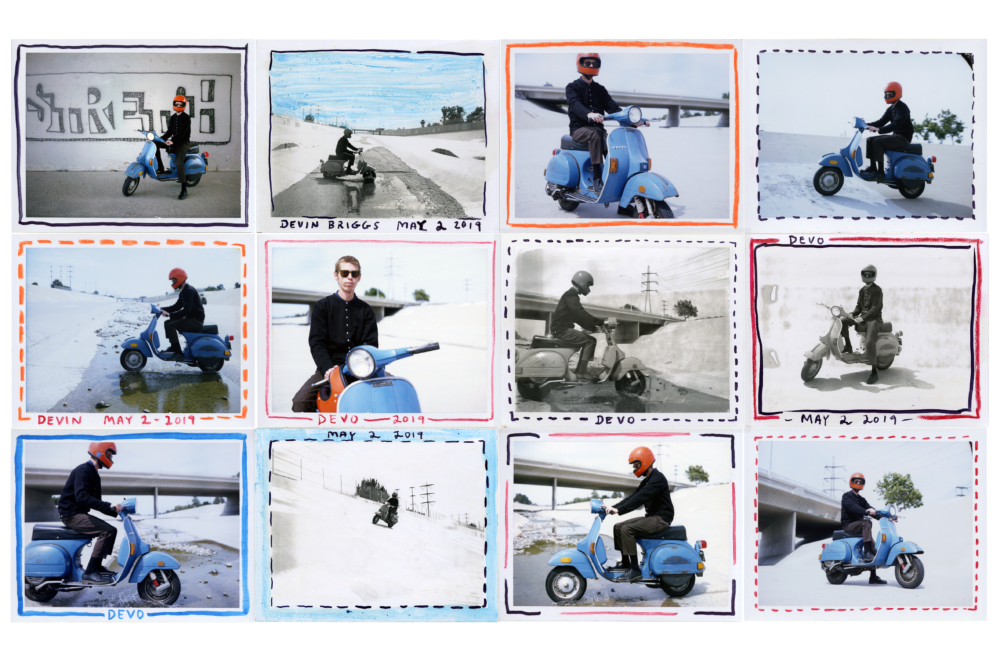
“Devin in the Riverbed,” 2020. © Ed Templeton
STROBECK: I thought it was cool. I liked it! I like almost all your stuff. It’s always very noticeable. It’s got your signature on it. I’ve always been a fan, and I think I even wrote you on Instagram at one point and told you that when I was 14 I had this neon green hat with a rope that goes across the brim. There was no writing on it, and I cut one side of the rope off so it hung out on the side. And then I wrote ‘Edwill’ because I was such a fan of yours. I’m still a fan, but this was when I first started skating. You were just there in front of my face, visually, with all New Deal and early stuff like that. I just came up with a nickname for myself. It’s funny to think about that talking to you right now. It’s amazing, being a kid, you’re just obsessed with different things.
TEMPLETON: I don’t picture you being old enough to remember New Deal. How old are you?
STROBECK: I’m 41. So I really loved New Deal when I was 14.
TEMPLETON: For some reason I thought you were younger.
STROBECK: I’m around young people all the time.
TEMPLETON: You look good!
STROBECK: Thank you! And you haven’t changed in a long time. I follow what you’re doing and I see that you’re going down to the pier all the time to shoot those photos, you’re amazing at it. You’re doing it in the same way that you would have done with Toy Machine. All that is your expression, it’s in your DNA. You’re getting super close photos of people and they’re all characters. It’s like a TV show over there!
TEMPLETON: It’s like shooting fish in a barrel. It’s not weird to have your phone in your hand. You can easily shoot stuff. I get close because I’m just walking by, full speed, and jamming my phone into their space.
Basically, I started shooting photos in a serious way in ’94, and the reason was to document my life as a pro skateboarder. I was living this crazy life. I got to travel the world and be around all these people who are partying hard and as a weirdo who didn’t party, I always felt like an outsider. So I started to shoot that culture. And that work has been present through all my stuff. There’s always been photos of skateboarders living life, but I’ve never put it into a form that is just about that.
STROBECK: So you’ve never done a book of just that stuff, Bam Margera, when he was younger, and Kerry Getz?
TEMPLETON: Have you seen that book with the bloody middle finger on the cover, called Golden Age of Neglect? 50% of that book is skateboard-related stuff. But the book was about my photography in general. So yeah, that stuff has never been put together. I’m making maps, figuring out all the tours I went on. I’m trying to really put it in a context of what the life of a pro skater is like, which is mostly waiting and traveling, and not actually physically skateboarding. All the waiting and all the getting around. You do a great job of that. I just watched “Cherry”, I love the street photography aspect of it. That’s how I always want my videos to look, with Toy Machine, but I physically don’t film anymore. So I get frustrated because I want my filmers to do what you do, which is approach skateboarding like a street photographer would. You’re observing the guys skating but also what’s happening in the background. Anyone who’s reading this should watch one of William’s videos and see how the documentation of the skateboarding itself is blended perfectly with a portrait of the city that he’s in, so you’re seeing street culture, which skateboarders are a huge part of, and there’s a seamless blend. You do a great job of capturing everything. You don’t put your hand in front of the camera to mark a trick, you keep filming. That’s what I always tell my videographers, “Don’t put your hand in the frame to mark the trick, keep filming because something else is gonna happen, always.”
STROBECK: First of all, thanks a lot for noticing, and giving me credit. The whole day is something to me. Like you said, I’m not partying and I feel like an outsider, so this is what I do to feel involved. You’re such a big part of that time period, with those kids especially. I’m kind of the same with these kids, but also not forcing anything upon them. I think that they were very independent, they knew what they thought was cool already. It wasn’t staged, they were just a crew of kids actually hanging out in Supreme. They ended up colliding with me at some point when I was filming and I made the video more about them because this is what skateboarding was missing. Everyone forgot about what it’s like to start skateboarding. Fortunately for me, these kids ended up getting really good really quick. They had that drive and they were skating with big pros. They wanted to prove themselves to themselves.
I’ve been doing it for a while now, and you’ve been doing it for way longer. What keeps me interested in it is really what you do when you’re skating, the tricks are secondary to me. Obviously, if we’re going to make a skate video, the skating has to be there. But I love anything that’s the non-skating part, the way someone looks, the shape they make, what’s happening at the spot. I think every little thing matters. That’s the way that I’m looking at it now because I’m mega picky. You’re an image-maker and collector, what you’ve done already helps you figure out what you want to do next. And I feel the same way, what is going to keep me interested next? Because I’ve already done things that I wanted to do. What can I do to keep myself entertained and keep these kids hyped to do it?
TEMPLETON: Yeah, you were at the right place at the right time for those kids. You’ve documented a time capsule of skateboarding that is going to be super valuable in the future. I didn’t necessarily know at the time that Bam Margera would go on to become an international star in film and TV shows. I didn’t know that Elissa Steamer would go down in history as being one of the landmark female street skaters or that B.A. Brian Anderson was gonna come out of the closet and become this iconic champion of gay skateboarders everywhere. All these things happened after the fact. It just changes the way my photos are going to be perceived as time changes. I think you’re in that same boat, you’ve captured a certain era of New York skateboarding street culture. I’m sure even if it came out right now, with some time to sort it out and figure it out, I guarantee you’d have an epic book.
STROBECK: Oh, yeah! Like you said, I’ve always been waiting on a book. People would always tell me “You should make a book of photos of everyone in front of your wall in your apartment.” I think that’s too easy. I don’t want to do that, it feels cheap. I haven’t made a book or a zine, and I’ve been asked to do it, but I just know when I know will be the right time. It’s going to be something that looking at it, I’ll be really happy that I’ve waited this long. I’m not at a place where you can look back at Bam Margera, Brian Anderson, Kerri Getz and Elissa Steamer. We’re not that far ahead of where these kids were when we first started, we’re like seven or eight years in now. But it feels like the kids have been 19 for, like, 10 years or something.
TEMPLETON: Well, look at Tyshawn’s Jones rise, it’s crazy! He was sponsored by us at one point. We loved him and thought he was awesome. And when he switched over to Fucking Awesome, it made total sense. It was a kind of natural path for him. But to see him get Skater Of The Year and just develop as a skater has been incredible to watch. And as a photo-nerd, I just look at you and I think, gosh, he’s got some cool shit. I’m sure he’s got an rad archive of people growing. It’s an amazing time capsule.
STROBECK: I agree. I put it out there pretty hard. I’m very quick with putting images up and I get really hyped. That’s just staying excited. That’s why my Instagram is so noticeable, it’s just an everyday kind of thing. Tyshawn [Jones] was obsessed with Toy Machine. He grew up watching Lizard King and he’s just very into that style of skater. When I was younger, I was totally obsessed with Toy Machine too. Your videos were giving me the same feeling I would hope my videos will give somebody. Yours are more fun and destructive, like the slam section in Welcome to Hell. I watched that not too long ago- it’s epic! And you did it so right, these were really groundbreaking videos. We were all waiting for the next one. You’ve been at the forefront of skating for so long and you always will remain a huge inspiration in that field without a doubt. It’s really rad to even get the chance to talk to you about it.
TEMPLETON: Hey, you’re making me blush…
STROBECK: You got photos of Alex Olson when he was little and he looked like a surfer kid. He looked like Peppermint Patty.
TEMPLETON: We called him Peppermint Patty!
STROBECK: He looks just like the cartoon, it’s amazing. We called him that when he came to New York.
TEMPLETON: Yeah, when I see him, I still say, “What’s up Peps?”
STROBECK: That’s so funny!
TEMPLETON: You just had a show, right?
STROBECK: I did have a show out here. It was the first show that I’ve ever had. And I had never done group shows or anything. I got asked if I wanted to do a show, I knew what the space was like, and I just knew the idea that I wanted to do out the gate, which was to bring this whole apartment there and literally build it. It had to be real, we brought every single thing over there, including the lights, the doors and everything. People I knew walked in and had vertigo because it was so real, it freaked them out! I wanted to give people the realistic feel of where all the photography and video came from in this little space. And then I started shooting photos of them in the apartment rebuilt. It was fun, and I liked it! It was an extension of what I’d been doing. I had been doing kind of the same thing for a while. So it felt really good to step out of my comfort zone and do something like that. I want to do something else again.
TEMPLETON: I’m sure it’s just the beginning. You’ll be doing a lot of stuff.
STROBECK: I want to make a movie or a short film. I know when I’m ready to do something else, I’ll commit to it.
TEMPLETON: I’m looking forward to it! I’m gonna go down to the garage now and start painting. I’ve been working on a series of paintings.
STROBECK: All right, well, listen. I’ll give you my address, give me yours and like you said we’ll send each other some stuff!
TEMPLETON: Let’s do it! Thanks, William, and talk to you later.

